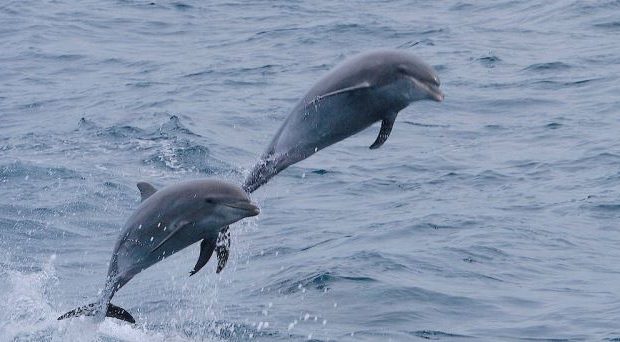29 July 2017, 06:45 am: it seemed a normal morning for the researchers of the oceanographic science vessel John P. Tully, navigating the waters off the west coast of northern Vancouver Island, British Columbia, Canada, for a routine open ocean survey.
It was surprising to find a warm-water dolphin in British Columbian waters.
Luke Halpin, lead author.
Suddenly, a naked eye sighting, then confirmed by binoculars and photographic records, turned the 29 July 2017 into a ‘date to remember’: a huge group of approximately 200 bottlenose dolphins (Tursiops truncatus) was observed traveling in aggregation with roughly 70 false killer whales (Pseudorca crassidens).
The herd approached the ship, traveling fast and breaching often, just occasionally slowing down, and regularly checking the surface by vertically poking their head out of the water, a behaviour called spyhopping, before traveling out of sight of the astonished crew by 07:25 am, after an encounter which lasted approximately 40 minutes.
For Luke Halpin, who was conducting this study for Halpin Wildlife Research, in collaboration with the Department of Fisheries and Oceans, Canada and the Department of Environment and Climate Change, Canada, ‘it was surprising to find a warm-water dolphin in British Columbian waters, and especially to find such a large number of common bottlenose dolphins within the group’.

The exceptional features of this spotting are several. First of all, the location of the sighting, which is approximately 1000 km north the typical range of common bottlenose dolphins off the west coast of North America. Previous observations had only spotted single individuals, likely vagrant or accidentally occurring so far north compared to their usual habitat.
But this is not the only surprise: although bottlenose dolphins are typically a group-living species, they are most often found in groups of 10-20 animals, which makes this sighting of 200 individuals even more interesting.
In addition to this, the sighting was also the ‘first offshore report of false killer whales in British Columbia’, says Halpin, which are warm-temperature to tropical species.
With marine waters increasingly warming up, we can expect bottlenose dolphins and false killer whales to naturally range into the north-eastern Pacific.
Dolphins and false killer whales are known to seek each other out and interact, but ‘to see the two species traveling together and interacting was quite special and rare’ concludes Halpin.
So, what could be the reason for this anomalous behaviour?
Although it is funny to think of dolphins and false killer whales deciding to take a group holiday to the fresh waters of Canada, there is a scientific explanation for this unusual phenomenon. As Halpin et al. describe in their recent publication in Marine Biodiversity Records, from 2013 to 2016, a prolonged ocean warming trend has been recorded, and it could represent the reason behind this incredible sighting.
Since 2014, several warm-water species have occasionally been documented in British Columbian waters. With marine waters increasingly warming up, we can expect bottlenose dolphins and false killer whales to naturally range into the north-eastern Pacific, as this could become a new, suitable habitat for these species.

Comments